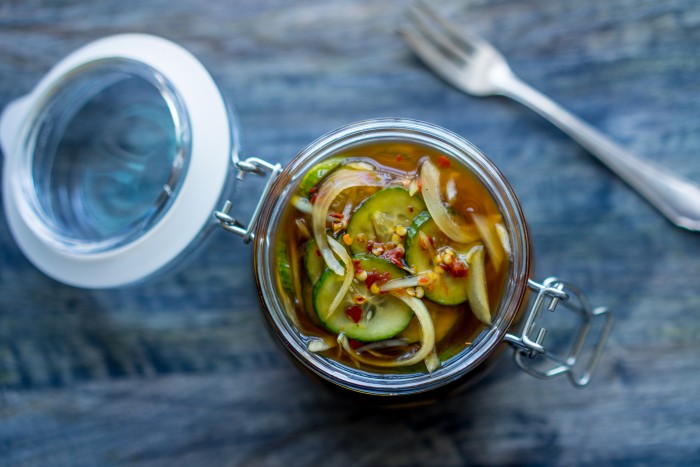As I observed recently, the Natural Products Expo West in March was filled with booths showcasing coconut in all its forms–everything from coconut water and coconut oil to coconut sugar and coconut ice cream. No question, this tropical fruit is enjoying its day in the culinary sun.
 It also has some distinct nutritional advantages. “Coconut is a great antibiotic,” says NOURISH Evolution advisor Rebecca Katz in her book The Cancer-Fighting Kitchen (Celestial Arts). “Half of its saturated fat content comes from lauric acid, which the body converts into monlaurin, a powerful antibacterial and antiviral compound. Monolaurin is the absolute enemy of disease-causing germs, and may play a role in attacking cancer as well.”
It also has some distinct nutritional advantages. “Coconut is a great antibiotic,” says NOURISH Evolution advisor Rebecca Katz in her book The Cancer-Fighting Kitchen (Celestial Arts). “Half of its saturated fat content comes from lauric acid, which the body converts into monlaurin, a powerful antibacterial and antiviral compound. Monolaurin is the absolute enemy of disease-causing germs, and may play a role in attacking cancer as well.”
Here are 5 forms of coconut, and how to use them:
Coconut Oil
Extracted from mature coconuts, coconut oil has a high smoke point so it can be used for high-temperature cooking. Choose unrefined coconut oil, which retains more of the beneficial fats than refined and has a rich, nutty flavor with hints of vanilla.
Use it: for sauteing, baking or anywhere you’d like to add a coconut-y note–like in our Creamy Millet with Blueberry Compote.
Canned Coconut Milk
You’ve probably used thick, creamy canned coconut milk to add rich texture to curries, like our Spring Vegetable Curry or Curried Mussels. It’s made from pressing fresh ripe coconut meat. Light coconut milk has about 60% fewer calories than the regular variety, and it’s still pretty rich.
Use it: In addition to curries, try coconut milk in baked goods, pancakes or anywhere you’d like to add a rich, nutty, tropical note. It’s also great for thickening sauces. Refrigerate leftover opened canned coconut milk for up to 3 days.
I also really like this tip from the Williams-Sonoma Kitchen Companion: Don’t shake the can before opening. Instead, skim some of the thick cream that has risen to the top to use in place of oil to make a curry paste. Then stir the rest of the oil back into the milk to use in the sauce.
Coconut Milk Beverage
This is a relative newcomer on the market, and you’ll find it in the refrigerated section of many health-food stores with other nondairy milks like soy or almond milk. It’s made with regular coconut milk but has a thinner consistency so you can drink it by the glass. It has a subtle coconut flavor. It has 50 calories per cup, including 25% of your saturated fat needs for the day.
Use it: Drink it like milk, pour it over cereal, use in baked goods, puddings and the like.
Coconut Water
If you’re the athletic type, you’ll want to take a close look at coconut water as a natural alternative to sports drinks. It’s made from young, green coconuts (as opposed to the mature brown fruit used to make coconut milk). Coconut water has about one-third fewer calories than a sports drink yet it’s higher in potassium, magnesium, calcium and iron–all electrolytes that are key for hydration. It’s also a good choice for kids and pregnant or lactating women.
Use it: Opt for unsweetened coconut water, which you also can use in cooking as well as for sipping.
Coconut Sugar
Also known as palm sugar, coconut sugar is made from the sap of the coconut tree’s unopened flower bud stalks. Its texture is a bit sandier than granulated sugar with a subtle caramel-y flavor similar to brown sugar (but it doesn’t have brown sugar’s moistness or “pack”). Once a health-food or ethnic market item, you now can find it in most supermarkets. (Double-check the label to be sure you’re picking up 100% coconut sugar–some variations from Asia are mixed with cane sugar.)
Some research indicates coconut sugar has a much lower glycemic index than granulated (or brown) sugar, which means it may produce smaller fluctuations in blood sugar levels. It also has about one-third fewer calories per teaspoon. But as with any added sweetener, the less you include in your diet, the better.
Use it: Try it in place of either granulated or brown sugar in sweet and savory recipes.















